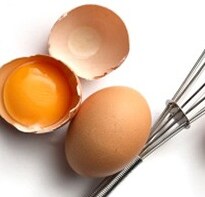It's natural to be nervous the first time you make mayonnaise. Though you're only trying to combine egg and oil in a nice, stable emulsion, mayo has a reputation for being temperamental, for curdling or splitting if you so much as look at it the wrong way. In truth, though, it's a doddle. So long as you take your time, it should turn out right every time.Which is why today's instructions avoid any machinery. It's easy enough to make mayonnaise in a blender or processor, but not only will you probably have to make far more than you need, you won't have such a close grasp of what's going on. It's better to use a bit of elbow grease at first.In a clean mixing bowl, place two egg yolks, 1 tbsp white-wine or cider vinegar and 1 tsp English mustard, or two of Dijon. Fill a small jug or bottle with 275ml oil - something mild-flavoured like groundnut or sunflower - optionally combined with no more than 75ml extra virgin olive oil (more may be overpowering).Using a balloon whisk, combine the eggs, vinegar and mustard, then start adding the oil, just a teaspoon at a time at first, whisking well with each addition. Once you've poured in about a quarter of the oil, you can add it a tablespoon at a go, again making sure you whisk everything thoroughly.
Advertisement
Photo: Mayonnaise is easy to make if you're patient, and easy to save if it does go a bit awry. Photography: Floortje/Getty Images
Advertisement
Advertisement
For the latest food news, health tips and recipes, like us on Facebook or follow us on Twitter and YouTube.
Advertisement
